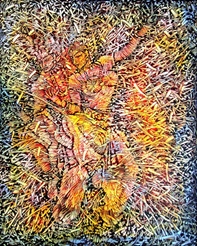माई री श्याम श्याम श्याम रटत श्यामा श्याम भई
अपनी सखिन सों पूछत हैं श्यामा कहाँ गयी
ब्रज बीथन में ढूँढत डोलत बोलत राधे राधे
रही निहार सोच कर सखी सकल मौन साधे
By chanting ‘Shyam Shyam Shyam’ Shyama (Radha) became Shyam
So our friends ask ‘Where did Shyama go?’
Searching everywhere in Braj & Beethan, they cried out ‘Radhe Radhe’
Thinking that there was a mist, they became silent.
We, who take so much pride in our individuality, what do we know of the pleasure of drowning ourselves in the Universal? The greatest of our Indian Saints have sung of this, have they not? And yet we hold on to our separateness, our egos, our individuality. In this world of no absolutes, why do we think that ‘I’ is absolute?
I recently saw a Ted talk recommended to me by one of my readers (Thank you Ravi). The speaker is Jill Bolte Taylor, a Harvard trained neuroscientist. She talks of her experience during a stroke in her left brain. As a scientist, she observed herself and the world around even as her brain failed. When the left brain stopped functioning, she says that her consciousness shifted into the present moment and she experienced herself ‘at one with the universe’. In a heartfelt and touching speech she says ‘I looked down at my arm and I realised that I can no longer define the boundaries of my body. I can’t define where I begin and where I end’. Is this what the mystics talk about? Is this how Radha, chanting the name of Krishna, found herself to be Shyam? In my last post, I asked myself if the brain was what we called Maya, the illusion which stopped us from seeing the universality of the world. Today I refine my question to myself, is it the left-hemisphere which is the culprit?
It is not often that I pick up Hindustani Classical Music for my posts; though I love it, my understanding of it is abysmal. Yet today it can be no song but this. I am featuring a special kind of Jugalbandi today, called a Jasrangi. Typically, male and female voices have different pitches, the male voice being deeper and occupying a lower frequency range. To sing together, men and women have to sing a whole octave apart so that the notes match. This is why we find very high pitched singers in the Bollywood as this is needed in duets. However, in classical music where men and women sing in their natural pitches, duets are hard to achieve. To overcome this problem, Pandit Jasraj has developed a style of duet in which the male and female voices sing different ragas at the same time. The ragas chosen are such that shifting the tonic of one raga to the madhyama creates the scale for the second raga. Whilst singing, the madhyama of the male singer matches the shadjam of the female singer. Choosing ragas which, after a tonic shift (Graha Bedam/Moorchana), use the same frequencies, there is no clash. And we the listeners hear a note which weaves from being one in the first raga and something else in the second raga. Is this what Radha felt, when she went from being Shyama to Shyam and then back to Shyama? In this rendition, the lyrics chosen are wonderfully appropriate as the ragas morph from Puriya Dhanashree to Shuddha Basant and back.


